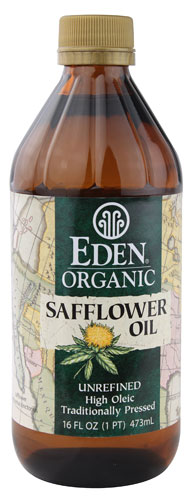Ever wander the cooking oil aisle endlessly, trying to decide which oil to buy? With such a vast array of cooking oils available in the grocery store today, selecting a single oil can be downright frustrating. So which to choose? The following tips will help you decide which oil to use and which to avoid depending on what type of dish you’re making.
Healthy for your heart
The good news is that most oils are considered “better for you” types of fats, as they are primarily composed of unsaturated fats, with the exception of palm and coconut oils, which contain mostly saturated fats. Unsaturated fats, particularly monounsaturated fats, have been shown to support normal cholesterol levels while saturated fats have a negative impact on LDL (the “bad”) cholesterol. Though unsaturated fats are touted as a health food, and an important part of a healthy diet, it is still wise to practice moderation as fats provide 100 calories in just a tablespoon.
Is there a “best” choice?
There really isn’t a single, all around, best cooking oil that passes all tests and functions in all scenarios with flying colors. Instead, there are better oils for certain purposes. One major factor that affects how an oil can be best used is the temperature it can be heated to. When an oil is heated past what is considered its “smoke point,” it begins to smoke and break down, affecting the flavor of the oil and producing free radicals. Here is an overview of six popular cooking oils and how best to use them.
1. Olive Oil
How it’s made: Olive oil is made from the fruit of the Olea europaea plant. For this reason, it is technically considered a “fruit juice” rather than an oil. The olives are crushed to form a paste and then placed in a centrifuge to extract the oil. Extra virgin olive oil is the oil obtained from the first pressing of the olives. Regular olive oil is more refined, or processed, than its extra virgin counterpart.
Smoke Point: Extra virgin olive oil: 320 degrees F; virgin olive oil: 420 degrees F
Use it: Olive oil can be used to cook with at moderate heats. However, heat may affect the flavor of the oil. Keep in mind that there are healthy compounds in olive oil, called phenols, which are compromised by heat. Extra virgin olive oil works well in a salad dressing or a bread dip.
When to avoid it: High-heat cooking
Recipe: Fig & Olive Oil Spoon Cake
2. Coconut oil
How it’s made: Coconut oil is made from copra, which is the dried “meat” of the coconut. It is either cold pressed or expeller pressed (using heat and pressure) to produce the oil. Coconut oil that has been centrifuged from fresh coconut meat can also be found. As mentioned above, coconut oil is unique in that it is actually high in saturated fatty acids. It should be used in moderation.
Smoke Point: 350 degrees F
Use it: As coconut oil is solid at room temperature, it makes a very good substitution for butter in baking. It is also good for moderate-heat cooking, as long as the slightly-sweet flavor of the oil complements the dish.
When to avoid it: Because coconut oil is solid at room temperature and below, it does not work very well in salad dressings.
Recipe: Coconut Oil Chocolate Chip Cookies
3. Canola Oil
How it’s made: Canola was developed as a cultivar of the rapeseed plant, bred to drastically reduce the erucic acid content of the rapeseed plant. The oil is removed from the canola seed through a process called “pre-press solvent extraction” in which the seeds are cooked, then pressed, then a solvent is applied to extract the remaining oil from the “presscake”. Canola oil also contains a substantial amount of monounsaturated fatty acids which support heart health.
Smoke Point: 400 degrees F
Use it: Canola oil is almost flavorless, and therefore appropriate for sautéing, frying or baking.
When to avoid it: Due to its lack of flavor, canola oil may not be the best oil for drizzling over veggies or in salad dressings.
Recipe: Vegetarian Soba Noodles with Curry-Spiced Tofu
4. Sesame Oil
How it’s made: Oils are extracted more easily from nuts and seeds when they are heated. Regular sesame oil is pressed from seeds that are heated to 250-300 degrees F. Seeds that are heated to 360 degrees F produce “toasted sesame oil”. Cold-pressed sesame oil also exists for those who prefer minimal processing.
Smoke Point: 410 degrees F
Use it: Oriental dishes; pairs nicely with soy sauce.
When to avoid it: It has a strong flavor, so avoid when a sesame flavor isn’t desired.
Recipe: Rainbow Sesame Slaw
5. Safflower Oil
How it’s made: Safflower oil is extracted from the seed of the safflower plant.
Smoke Point: 450 degrees F
Use it: There are two types of safflower oil. High-oleic safflower oil is higher in monounsaturated fatty acids, which make it more stable for high-heat cooking. High-linoleic safflower oil is higher in polyunsaturated fats, making it more desirable for lower-heat cooking.
Avoid it: Neutral flavor, so may not be ideal in salad dressings.
Recipe: Gluten-Free Cinnamon-Apple Potato Pancakes
6. Avocado Oil
How it’s made: Avocado oil is pressed from avocados to make a guacamole-like substance that is then centrifuged to separate the oil from the pulp.
Smoke Point: 520 degrees F
Use it: Avocado oil performs well in high-heat cooking situations such as frying or sautéing. Is can also be used in salad dressings and bread dips. Refrigeration helps keep its avocado flavor, but bring it to room temperature immediately before use.
When to avoid it: When a slight avocado flavor isn’t desired.
Recipe: Cilantro-Lime Dressing
Contributed by Jessica Riggs, MS, RDN
Registered Dietitian Nutritionist with The Little Clinic




